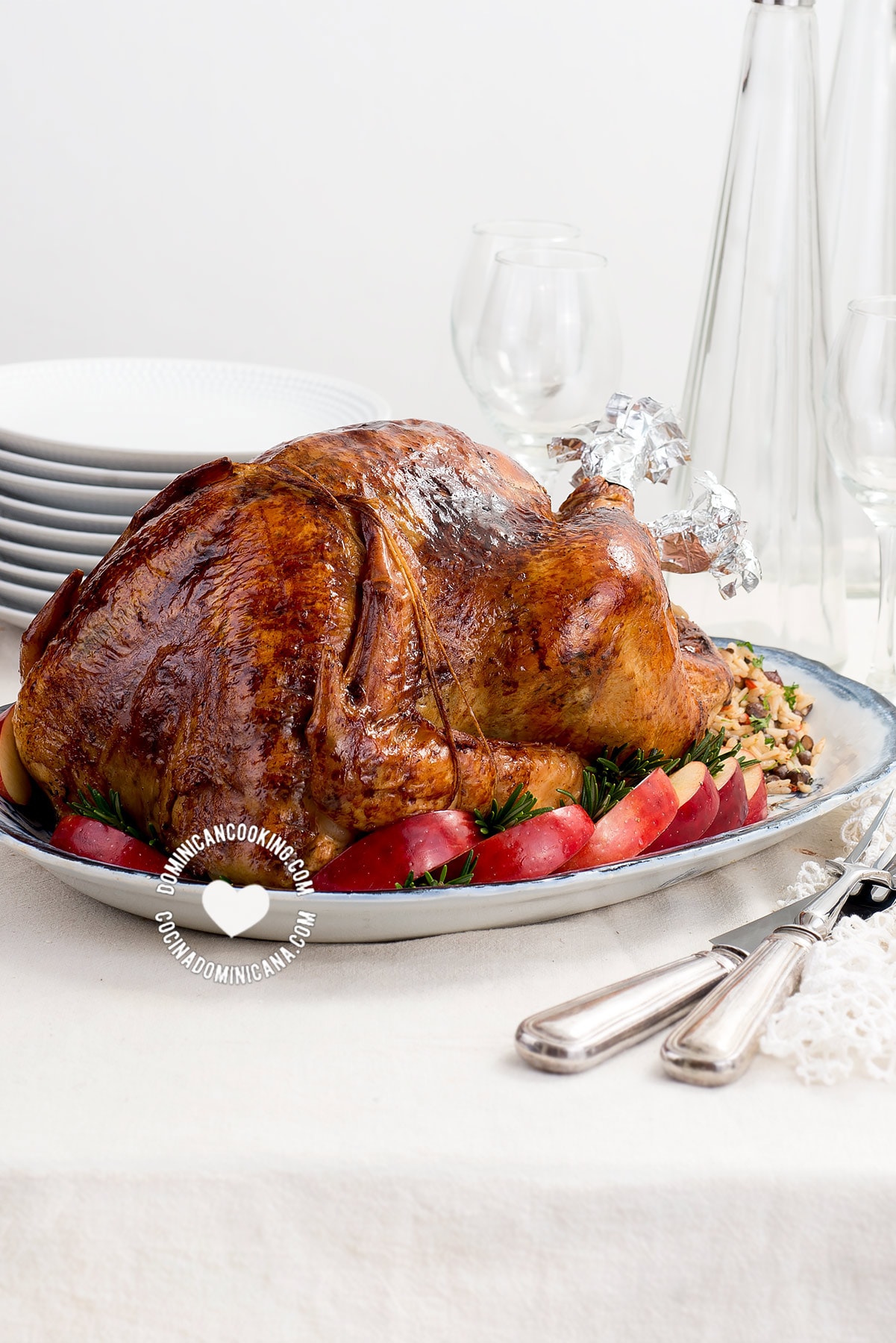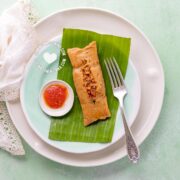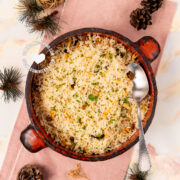Try this recipe of turkey a la Dominicana stuffed with rice (moro de guandules) and serve an exquisitely seasoned, impossibly juicy, meat. A traditional dish rediscovered and improved.
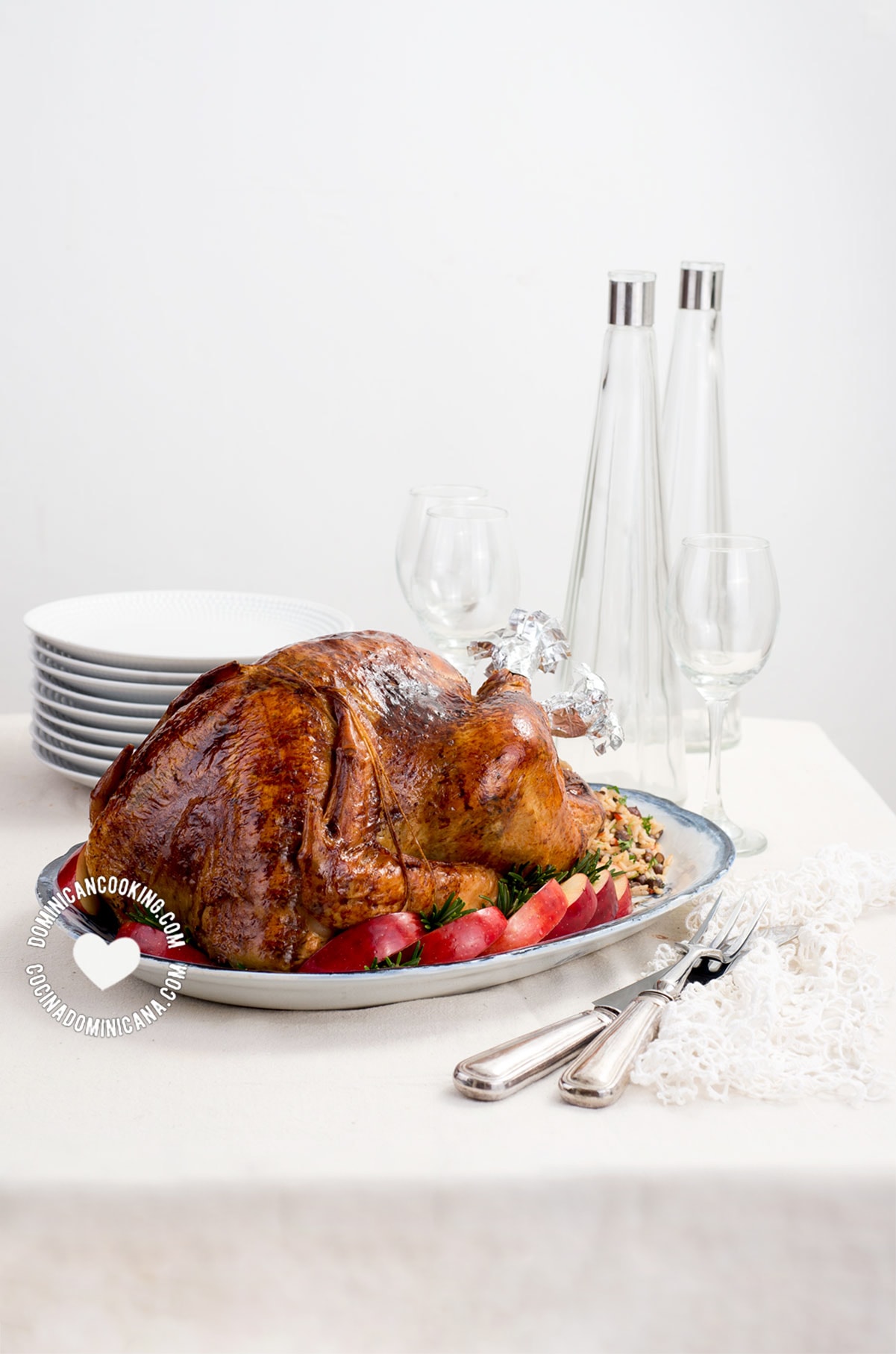
Why we ❤️ it
Y allá en la cocina / Ruidos de sartenes / Que sacan del horno / Pavos y pasteles.
Juan Antonio Alix [1]
This Dominican-style turkey stuffed with rice and guandules is incredibly flavorful, the meat was fall-off-the-bone tender, unexpectedly juicy, and the rice inside soaked all the runaway flavors, so it was just like an explosion of flavors. I ate this with gusto. I bet you will too.
Let me tell you something: I am so very proud of this Christmas turkey recipe. It worked like a charm. No turkey I've ever had before measures up to this one.
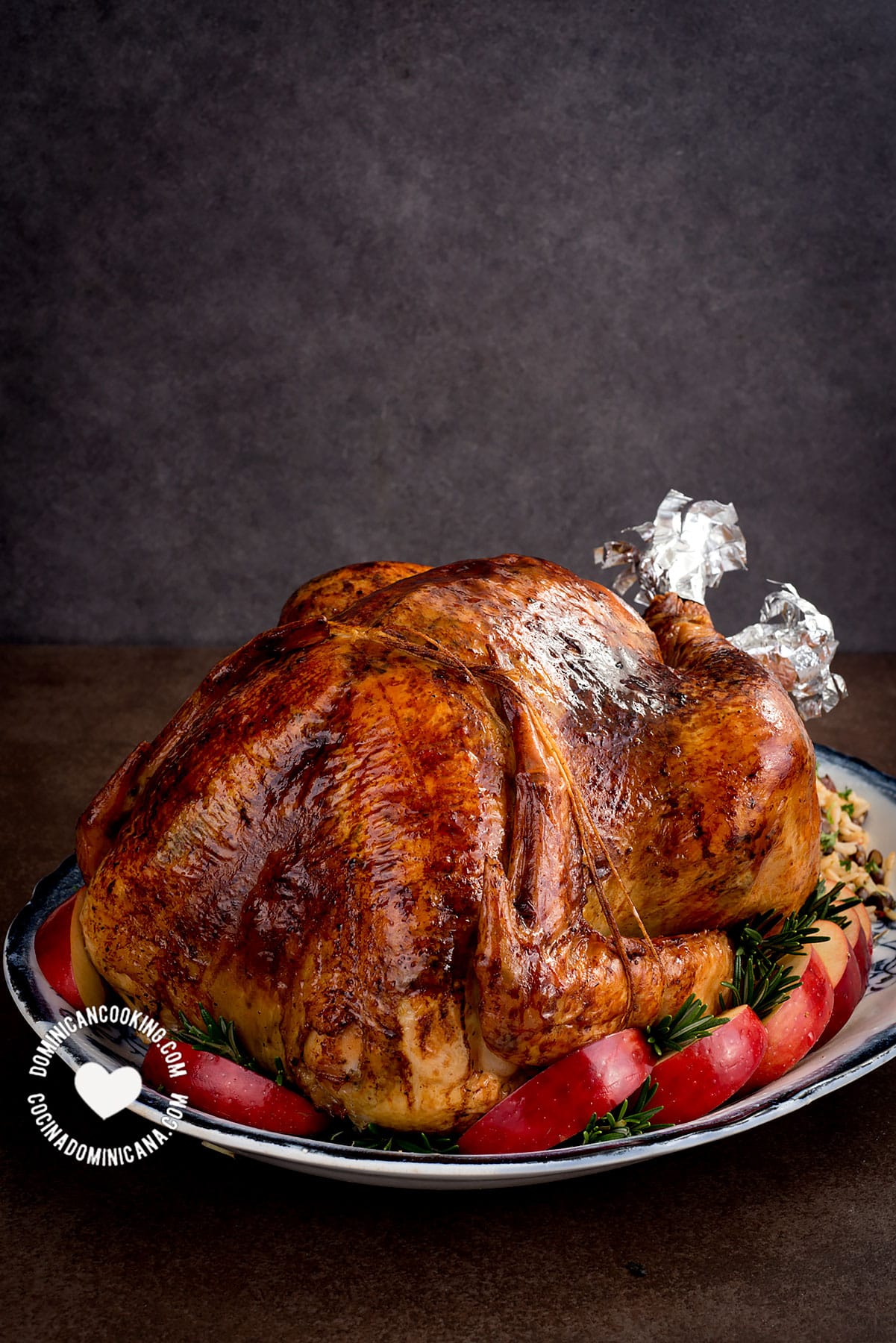
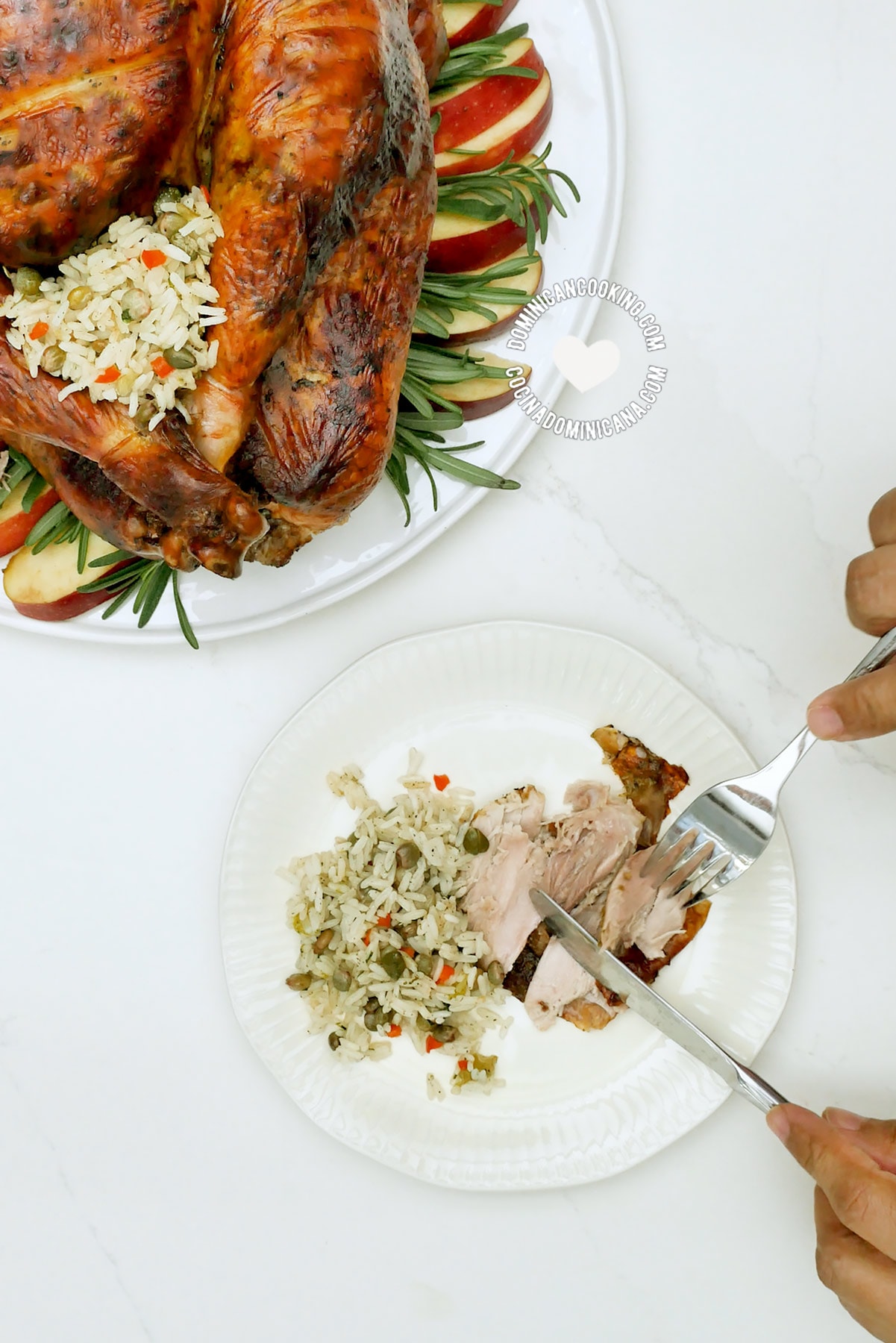
History
It used to be that turkey was a big part of our holiday celebrations, and while never as popular as pork, I have to say that our Turkey a la Dominicana is most certainly firmly steeped in tradition. There's even a couple of old carols that mention it [2].
My grandparents used to have turkeys on their farm. They certainly didn't look like the kind of turkey we buy in supermarkets nowadays. They were scraggly, skinny birds. The meat was lean, flavorful but tough, as is the usual with free-range animals.
Somewhere along the way, turkey became an uncommon dish. We think of it more as a U.S. tradition, and our puerco asado remains king as the centerpiece of our holiday feasts. Even chicken is more common nowadays.

How to thaw
If you bought the meat already frozen, or you have to freeze it until the day of preparation, thaw the turkey by placing it in the refrigerator for 48 hours or one day for every 5 pounds of meat. This is the safest and easiest method [3]. It is not recommended to force the thawing process by leaving it out of the refrigerator or heating it in any other way.
Serving suggestions
As with lechón asado and pollo asado, pavo navideño is served with moro de guandules (rice with pigeon peas), the version without coconut is the one used in this recipe. Ensalada rusa (potato salad) and pastelones, like pastelón de plátano maduros (ripe plantain casserole), pastelón de yuca (cassava casserole), and pastelón de papa (potato casserole) can also make an appearance at the Christmas table. Telera (Christmas bread), is a must, along with several other dishes from the traditional Christmas menu.
It varies depending on the family's tastes and budget.
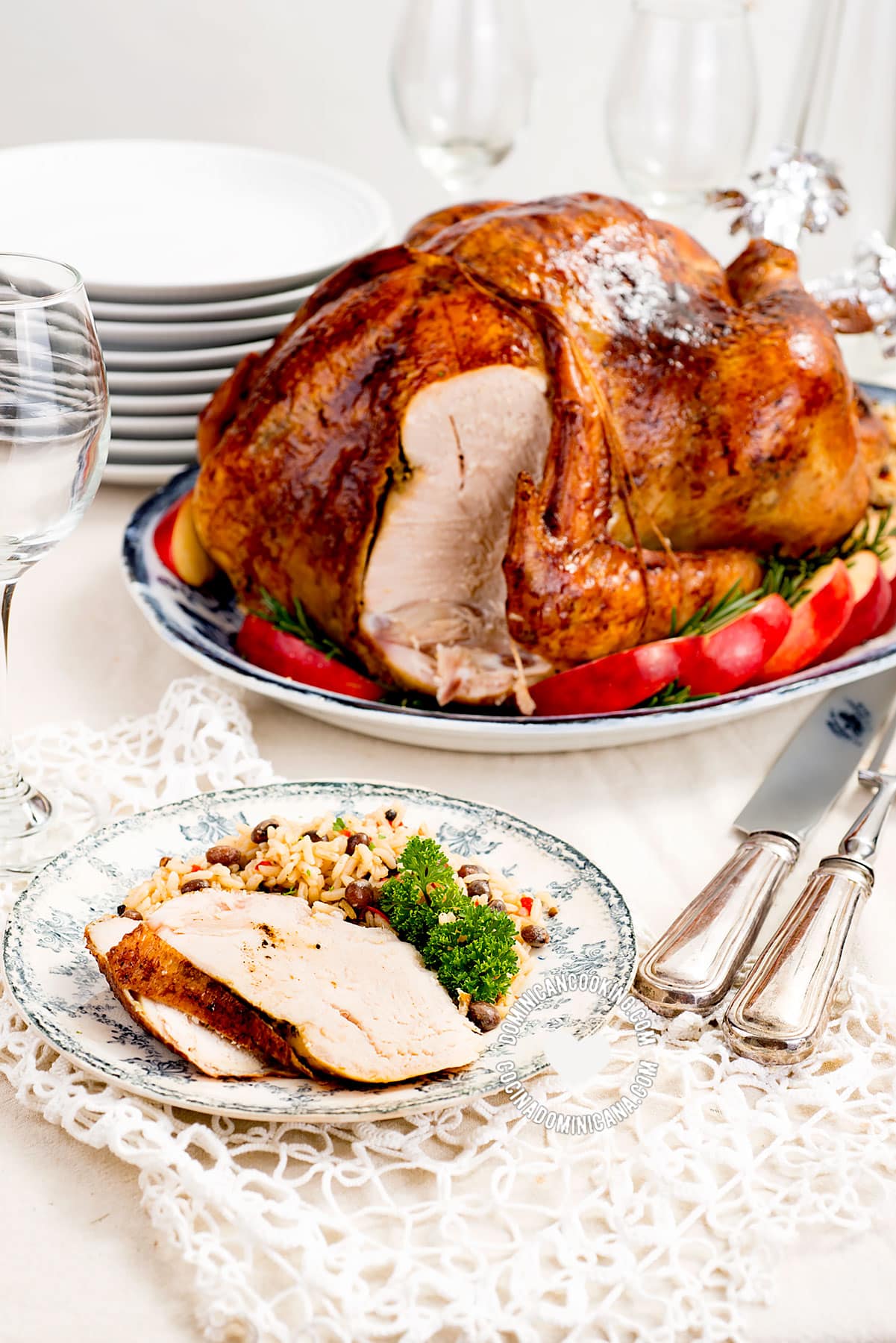
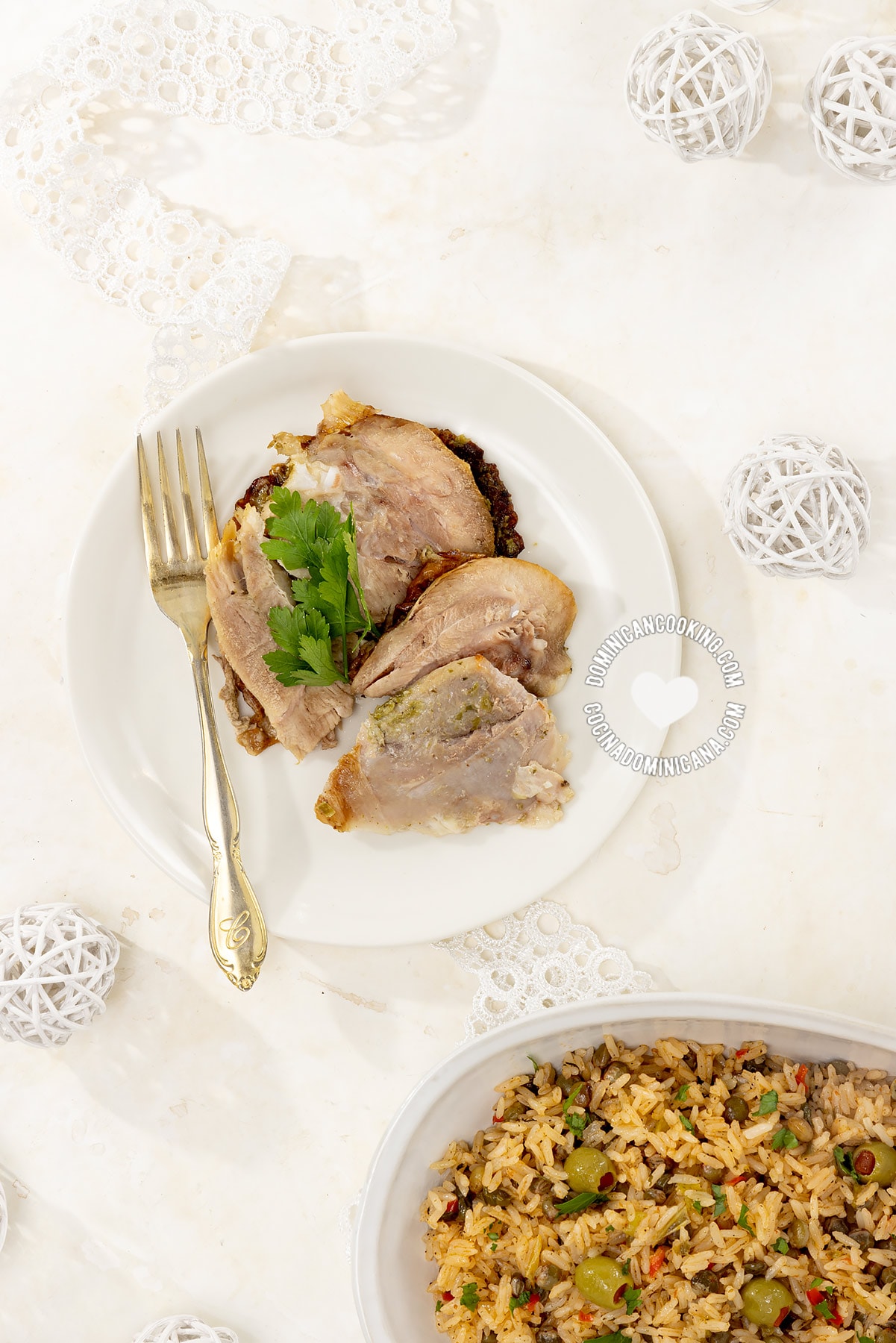
About this recipe
You'll notice we'll cook half of the rice fully, and leave half of the rice partially uncooked. The latter will finish cooking inside the turkey, and absorb a lot of the flavors of the seasoning, and the turkey itself. Personally, I love all the flavor in the stuffing, but some may find it a bit overpowering, so you have some extra rice to mix it with if that were your case.
You can make this with another stuffing of your choice, but I have not tested the recipe with another one.
The Dominican style of seasoning and marinating for a long time works so wonderfully with this meat. It works not unlike the traditional U.S. method of brining, only that this infuses the meat with some very strong flavors, and tenderizes it a whole lot more.
You'll notice that I have made some changes to the traditional Dominican recipe, namely adding butter to it (which makes it juicy and tender), and browning (for a lovely brown color). The latter is optional but advisable.

Recipe
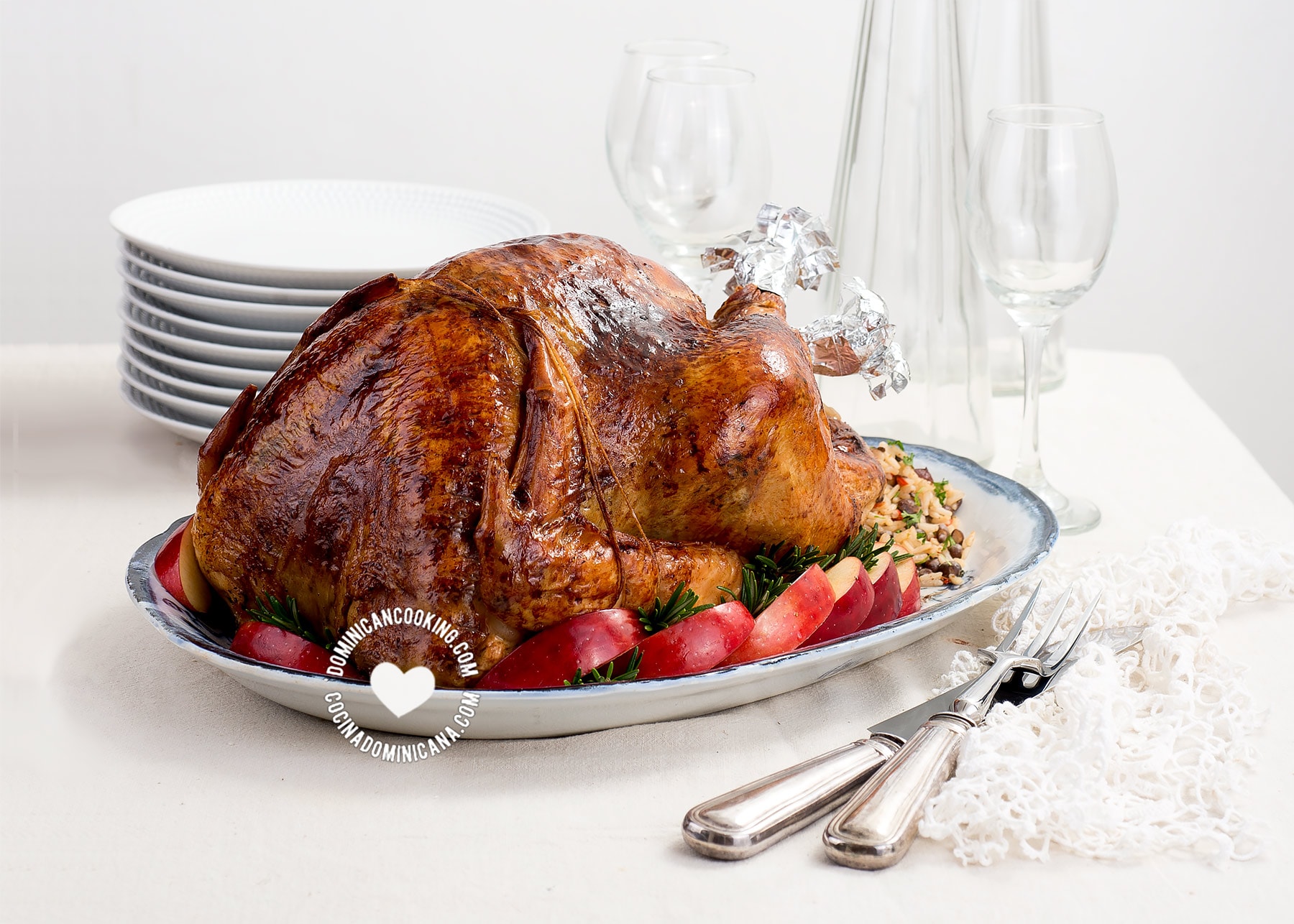
[Recipe + Video] Pavo a la Dominicana (Turkey Stuffed with Rice & Guandules)
Ingredients
For seasoning turkey
- 1 small red onion, chopped
- 6 clove garlic
- ¼ cup capers
- 3 tablespoons salt
- 1 bunch parsley
- Juice of 1 lime
- ¼ cubanela (cubanelle pepper), or bell pepper, chopped
- ½ tablespoon pepper (freshly-cracked, or ground), freshly cracked
- 1 whole turkey, About 9 lb [4 kg] unbrined turkey, thawed
For moro de guandules
- 1 tablespoons olive oil
- 1 teaspoon chopped cilantro
- ½ teaspoon mashed garlic
- 1 cubanela (cubanelle pepper), chopped
- 1 pinch oregano (dry, ground)
- 1 teaspoon salt
- 1½ cups guandules (pigeon peas), boiled or canned (drained)
- 2 cups rice
For roasting
- 1 tablespoon of browning, (affiliate link)
- ⅓ cup butter (salted), at room temperature, divided
Instructions
Seasoning turkey (a day before roasting)
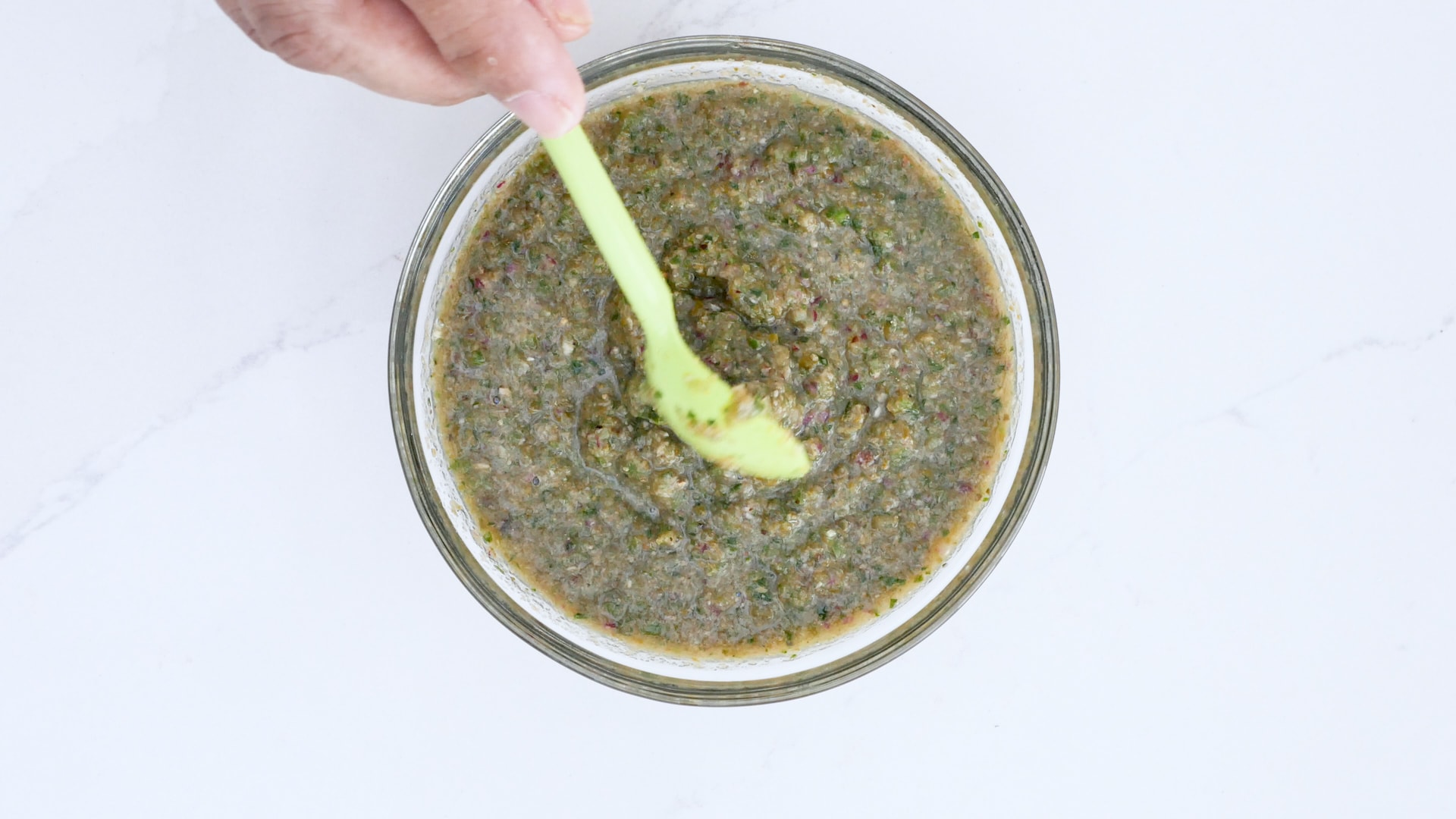 Making the seasoning: Mix the ingredients for the seasoning and blend in the food processor to obtain a coarse paste.
Making the seasoning: Mix the ingredients for the seasoning and blend in the food processor to obtain a coarse paste.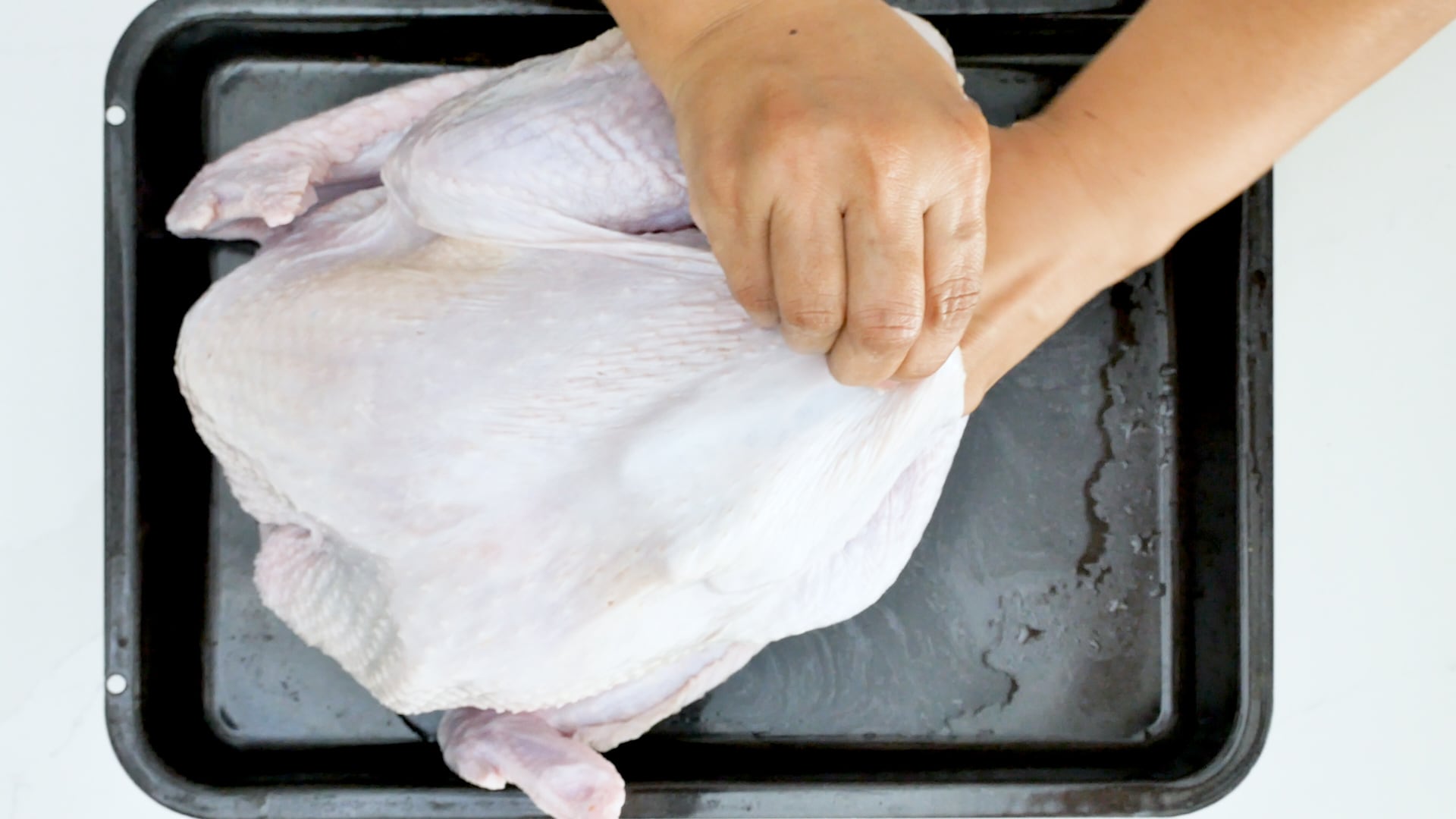 Separate skin: Slowly work your hand between the skin and the turkey meat, making sure not to pierce through the skin, separating as much as possible all the way down to the legs and neck (we're no skinning the turkey, just making space to rub seasoning under the skin).
Separate skin: Slowly work your hand between the skin and the turkey meat, making sure not to pierce through the skin, separating as much as possible all the way down to the legs and neck (we're no skinning the turkey, just making space to rub seasoning under the skin).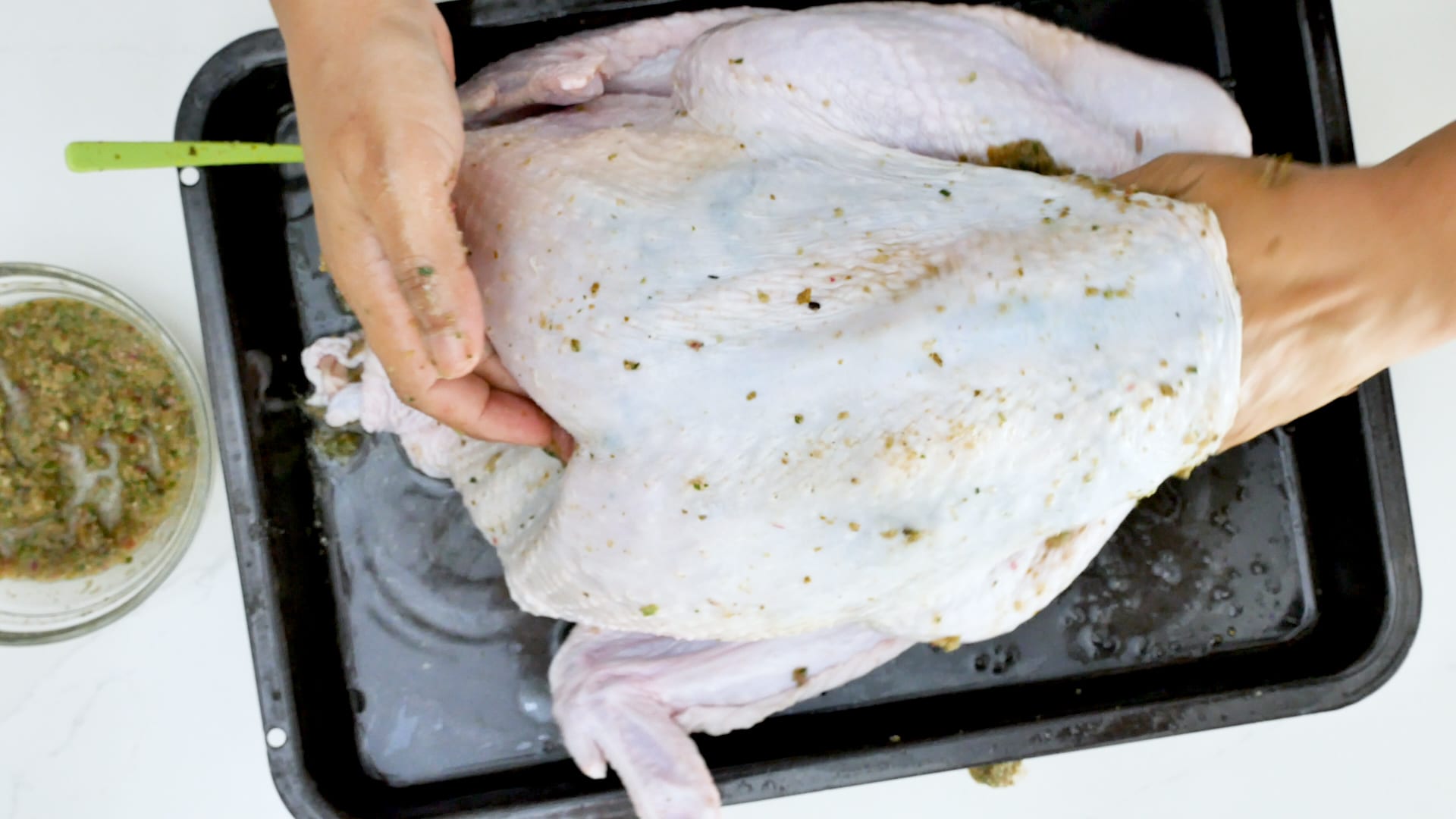 Seasoning the turkey: With a sharp knife carve 4 small holes into each side of the breast meat (don't pierce the skin!) and stuff them with the seasoning. Rub the rest of the seasoning under the turkey skin and inside the cavity. Place the turkey in a lidded container, or cover with aluminum foil, and refrigerate for 24 to 36 hours. Take out of the fridge a couple of hours before roasting to let it reach room temperature, while it does, make the stuffing.
Seasoning the turkey: With a sharp knife carve 4 small holes into each side of the breast meat (don't pierce the skin!) and stuff them with the seasoning. Rub the rest of the seasoning under the turkey skin and inside the cavity. Place the turkey in a lidded container, or cover with aluminum foil, and refrigerate for 24 to 36 hours. Take out of the fridge a couple of hours before roasting to let it reach room temperature, while it does, make the stuffing.
Making the stuffing (right before roasting the turkey)
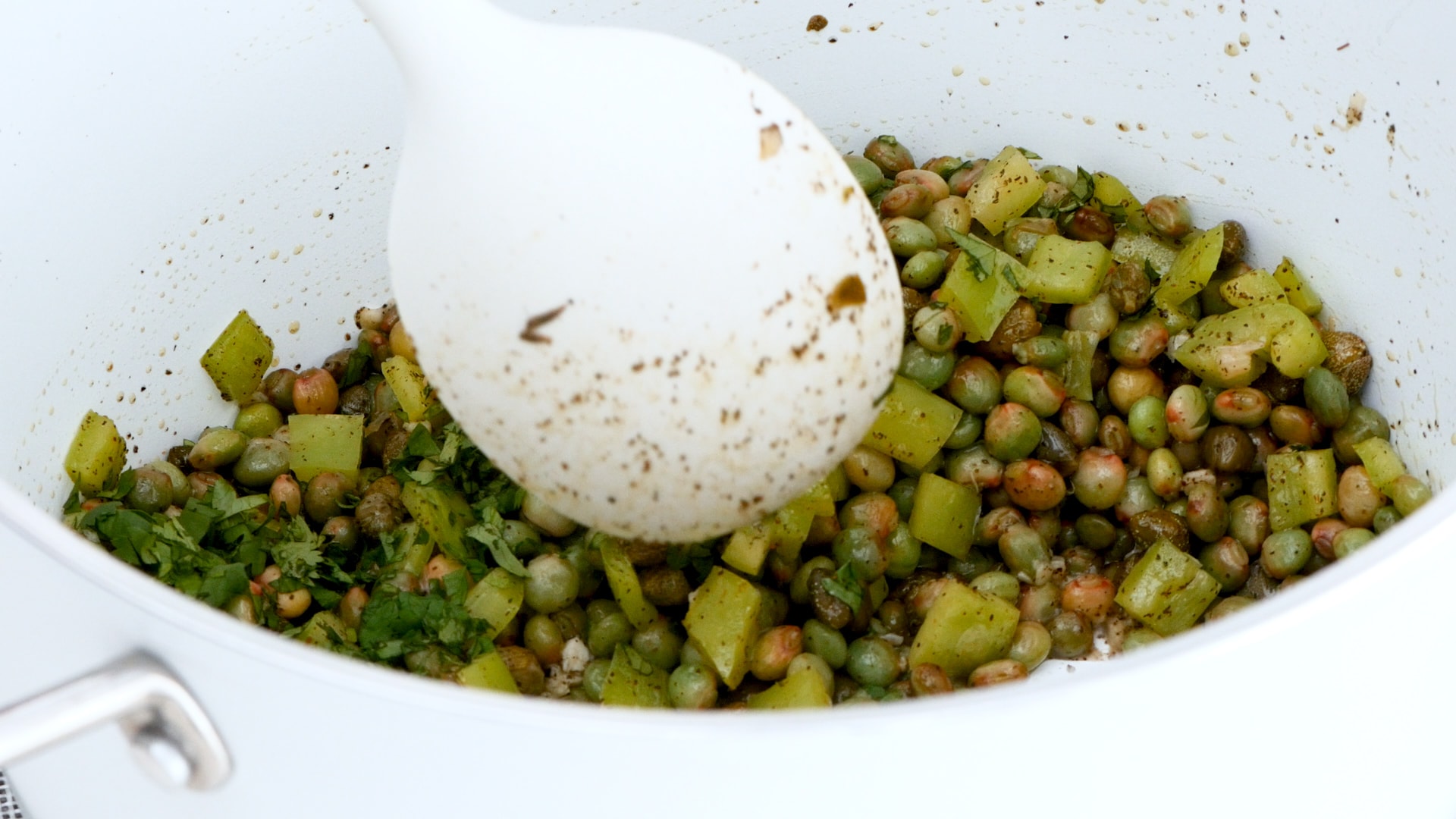 Sauteing seasoning: Heat the oil in a ½ gal [2 lt] iron pot over medium heat, and add the cilantro, garlic, peppers, oregano, and salt and cook and stir for a minute. Add the peas, also while stirring. Once well heated, add 1¼ cups of water and bring to a boil.
Sauteing seasoning: Heat the oil in a ½ gal [2 lt] iron pot over medium heat, and add the cilantro, garlic, peppers, oregano, and salt and cook and stir for a minute. Add the peas, also while stirring. Once well heated, add 1¼ cups of water and bring to a boil.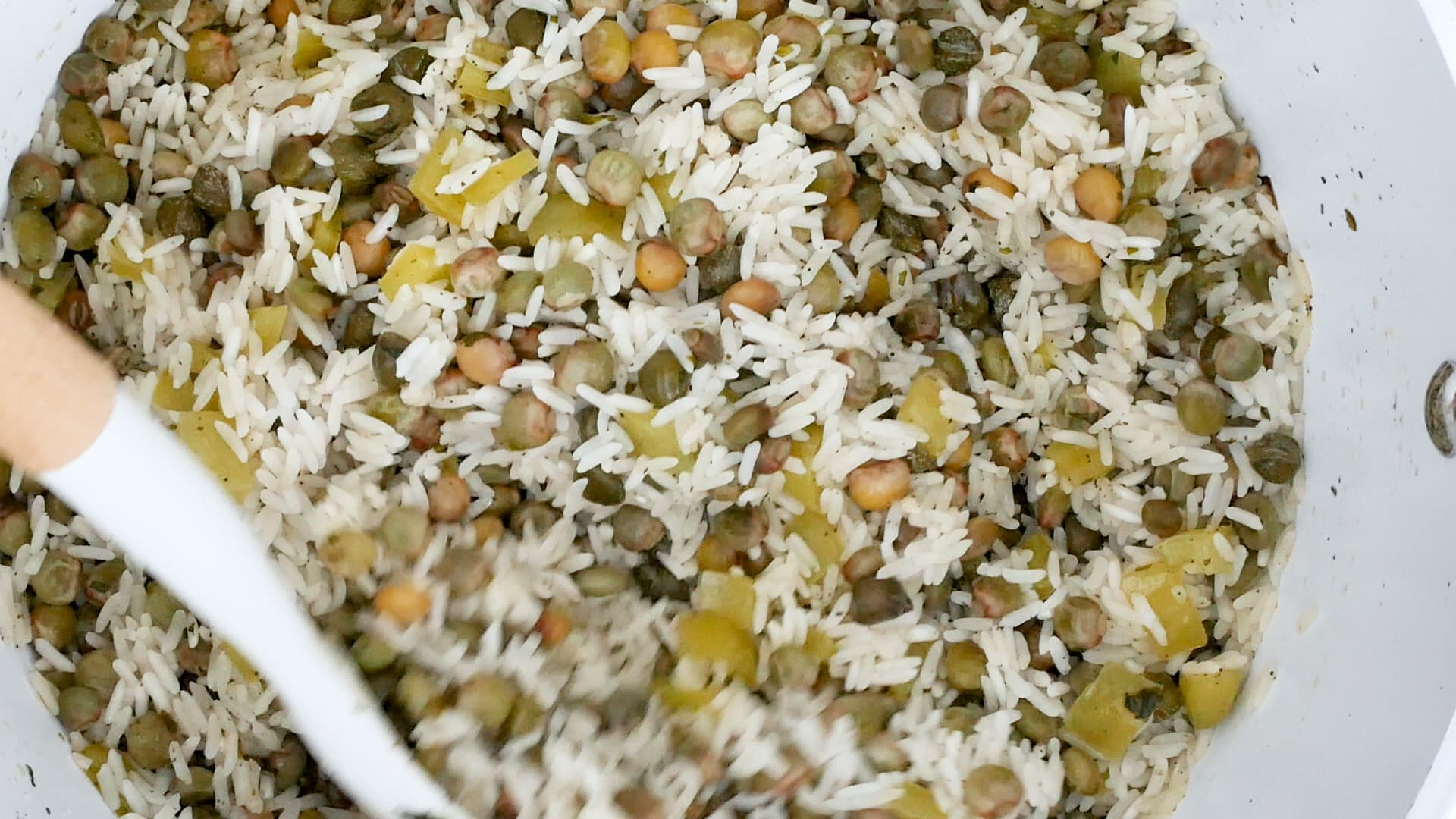 Cooking rice: Stir in rice and simmer over medium heat, stirring regularly and removing as much as you can of the rice that sticks to the bottom. When all the water has evaporated set aside half of the rice (still not fully cooked!) to stuff the turkey, and cover the pot with the remaining rice with a tight-fitting lid and simmer over very low heat.
Cooking rice: Stir in rice and simmer over medium heat, stirring regularly and removing as much as you can of the rice that sticks to the bottom. When all the water has evaporated set aside half of the rice (still not fully cooked!) to stuff the turkey, and cover the pot with the remaining rice with a tight-fitting lid and simmer over very low heat.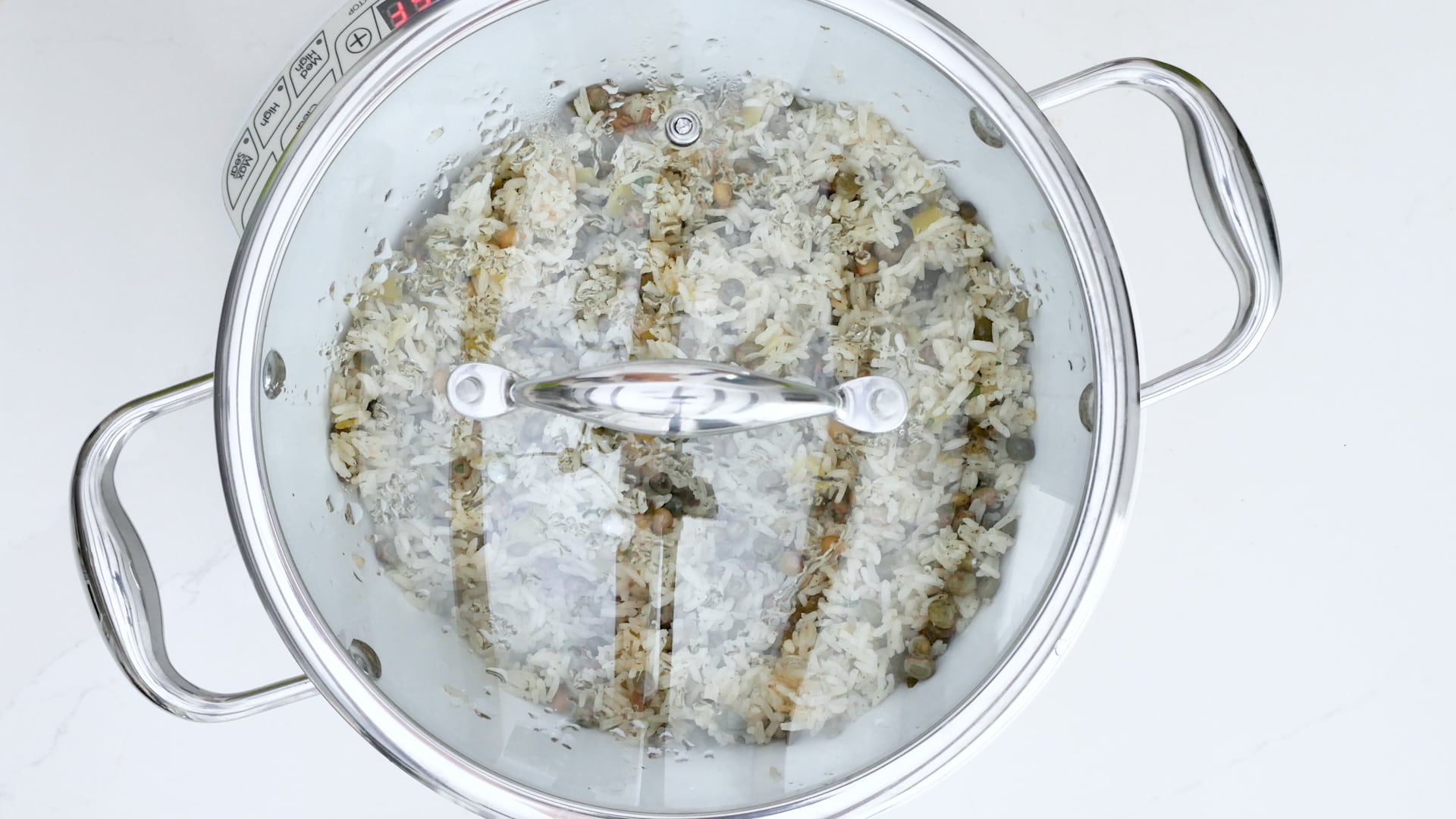 Finish cooking: Simmer for 20 minutes. Move the rice from the bottom to the top so it cooks uniformly. Cover again and simmer for another 5 minutes.Uncover and taste for doneness. The rice should be firm but tender inside. If necessary, cover and simmer another 5 minutes over very low heat. Spoon into a serving bowl and keep covered until it's time to serve.
Finish cooking: Simmer for 20 minutes. Move the rice from the bottom to the top so it cooks uniformly. Cover again and simmer for another 5 minutes.Uncover and taste for doneness. The rice should be firm but tender inside. If necessary, cover and simmer another 5 minutes over very low heat. Spoon into a serving bowl and keep covered until it's time to serve.
Roasting
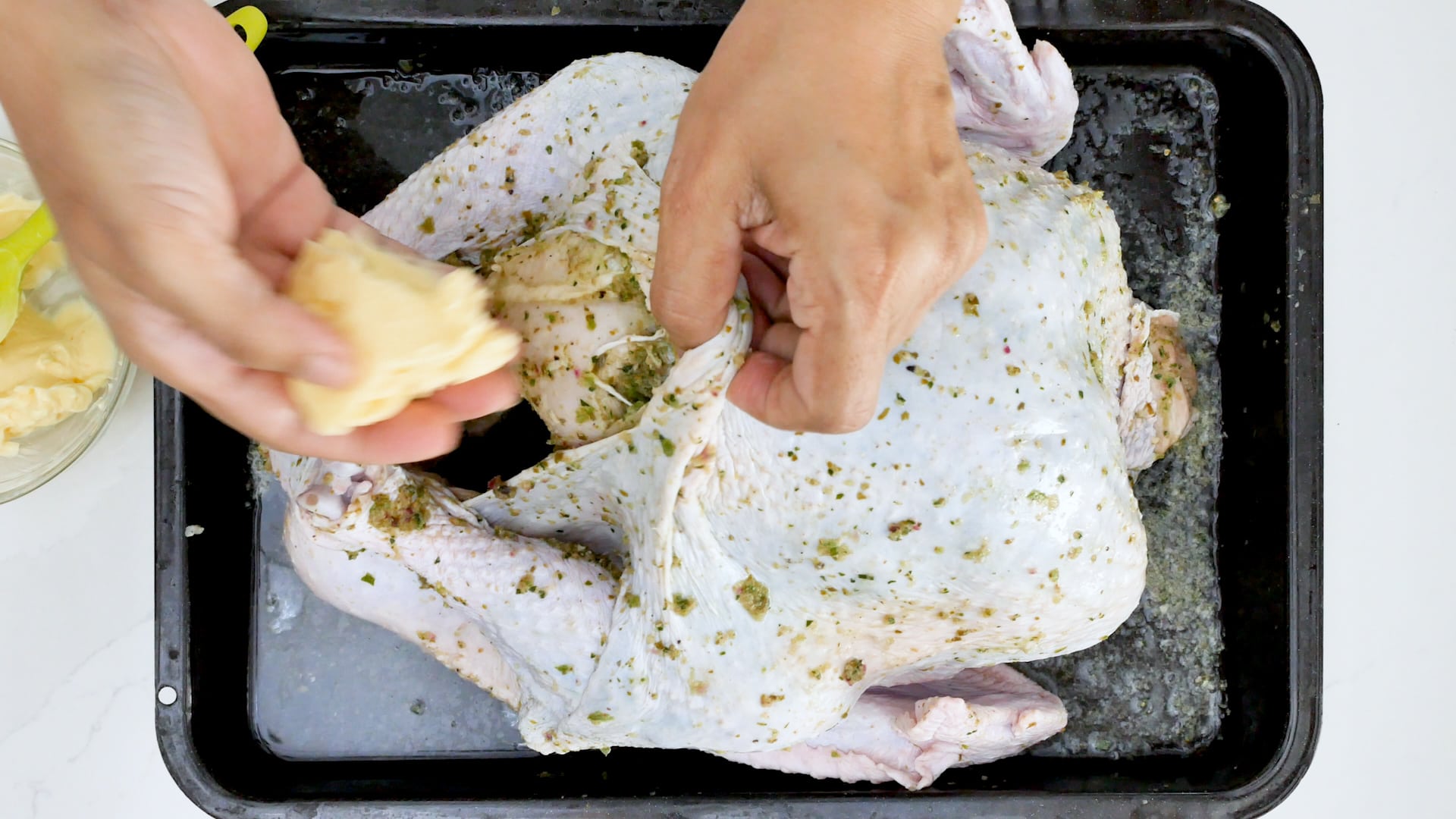 Prepare for roasting: Heat the oven at 325 ºF [160 ºC].Spread ¾ of the butter under the turkey skin. Stuff the holes you carved with some butter, set aside the rest of the butter for later use.Stuff the turkey with the partially-cooked rice.
Prepare for roasting: Heat the oven at 325 ºF [160 ºC].Spread ¾ of the butter under the turkey skin. Stuff the holes you carved with some butter, set aside the rest of the butter for later use.Stuff the turkey with the partially-cooked rice.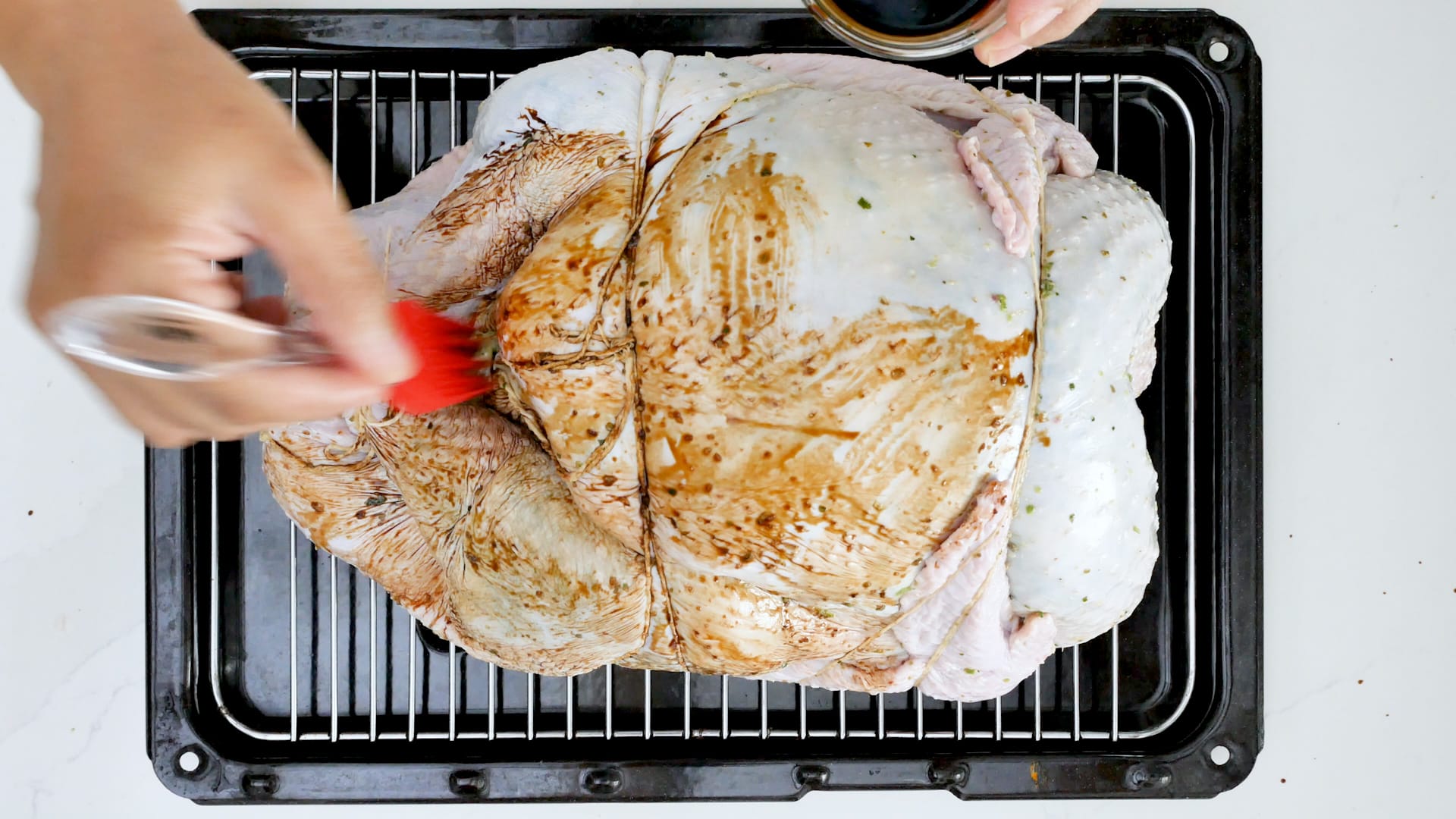 Stuffing: Place on a baking tray with a wire rack (see below the recipe). Pull the skin to cover the turkey all over. Tie the legs with twine. Tie the wings tight against the skin by wrapping twine around the turkey.Paint all over the skin with browning.
Stuffing: Place on a baking tray with a wire rack (see below the recipe). Pull the skin to cover the turkey all over. Tie the legs with twine. Tie the wings tight against the skin by wrapping twine around the turkey.Paint all over the skin with browning.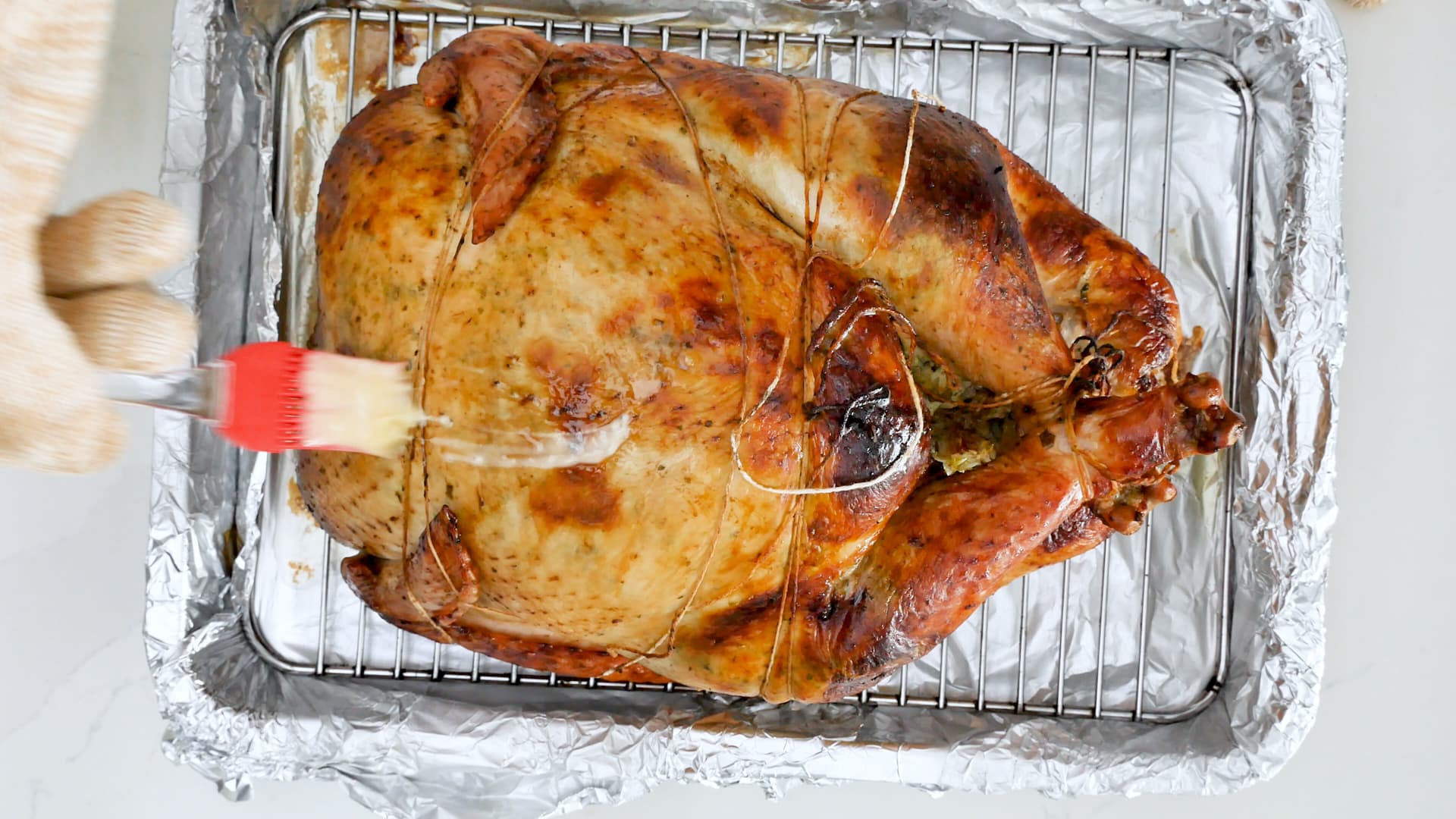 Roasting: Roast the turkey for 2½ hours, brushing all the exposed skin with butter every half hour. If any part starts to brown faster than the others, cover it with aluminum foil.
Roasting: Roast the turkey for 2½ hours, brushing all the exposed skin with butter every half hour. If any part starts to brown faster than the others, cover it with aluminum foil.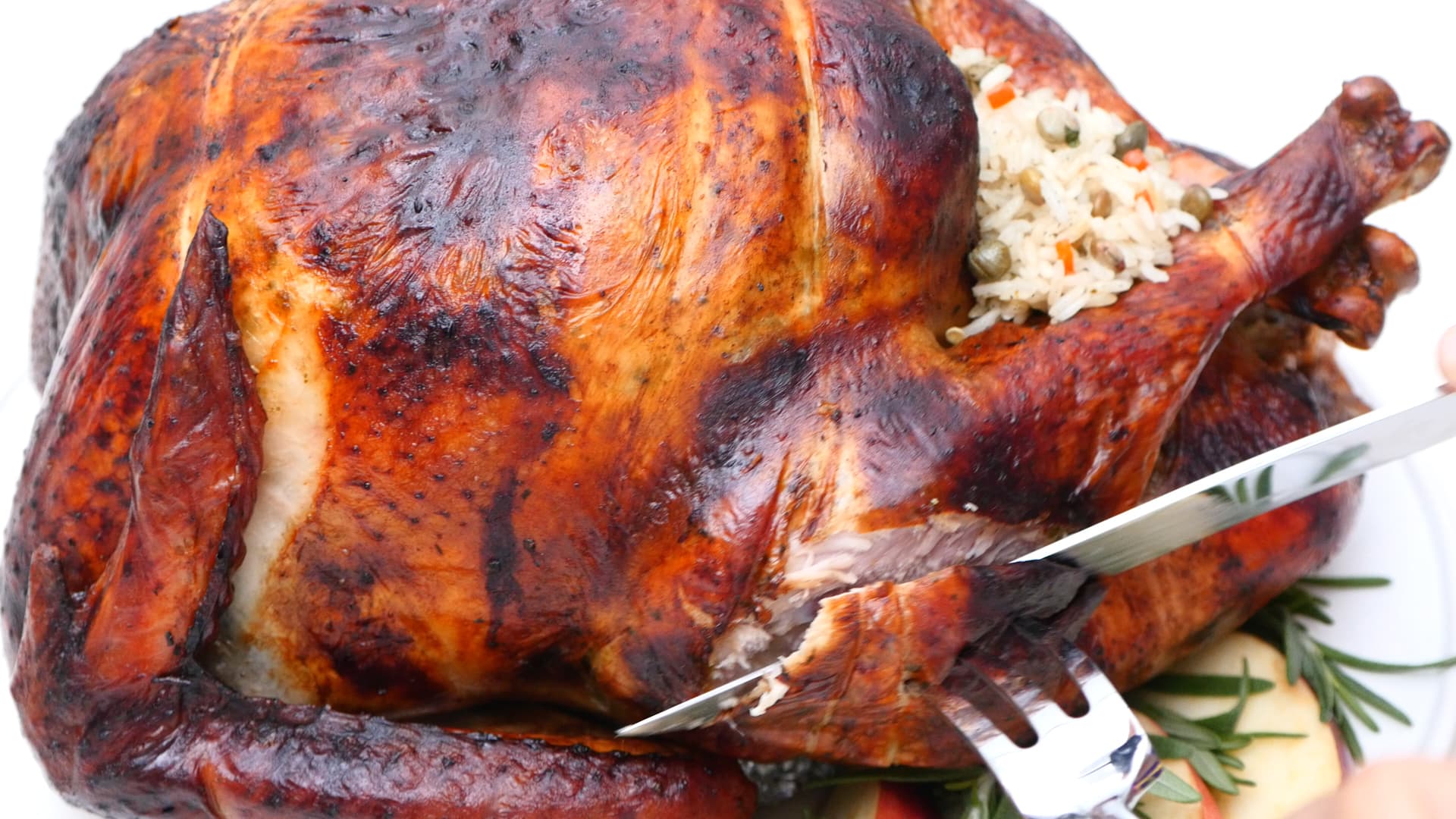 Check for doneness: Once the 2½ hours have passed, test the turkey breast with a meat thermometer (see below the recipe). It should have reached 165 °F [74 ºC] when you hit the bone. You should also test inside the leg where it hits the ribs. If it hasn't reached that temperature, cook for another 20 minutes, and test again.If you don't have a meat thermometer, stab inside the thigh all the way to the bone, it is done if the juices run clear, and there's no sign of blood or pink meat. Cook for another 20 minutes, if necessary, and test again.
Check for doneness: Once the 2½ hours have passed, test the turkey breast with a meat thermometer (see below the recipe). It should have reached 165 °F [74 ºC] when you hit the bone. You should also test inside the leg where it hits the ribs. If it hasn't reached that temperature, cook for another 20 minutes, and test again.If you don't have a meat thermometer, stab inside the thigh all the way to the bone, it is done if the juices run clear, and there's no sign of blood or pink meat. Cook for another 20 minutes, if necessary, and test again.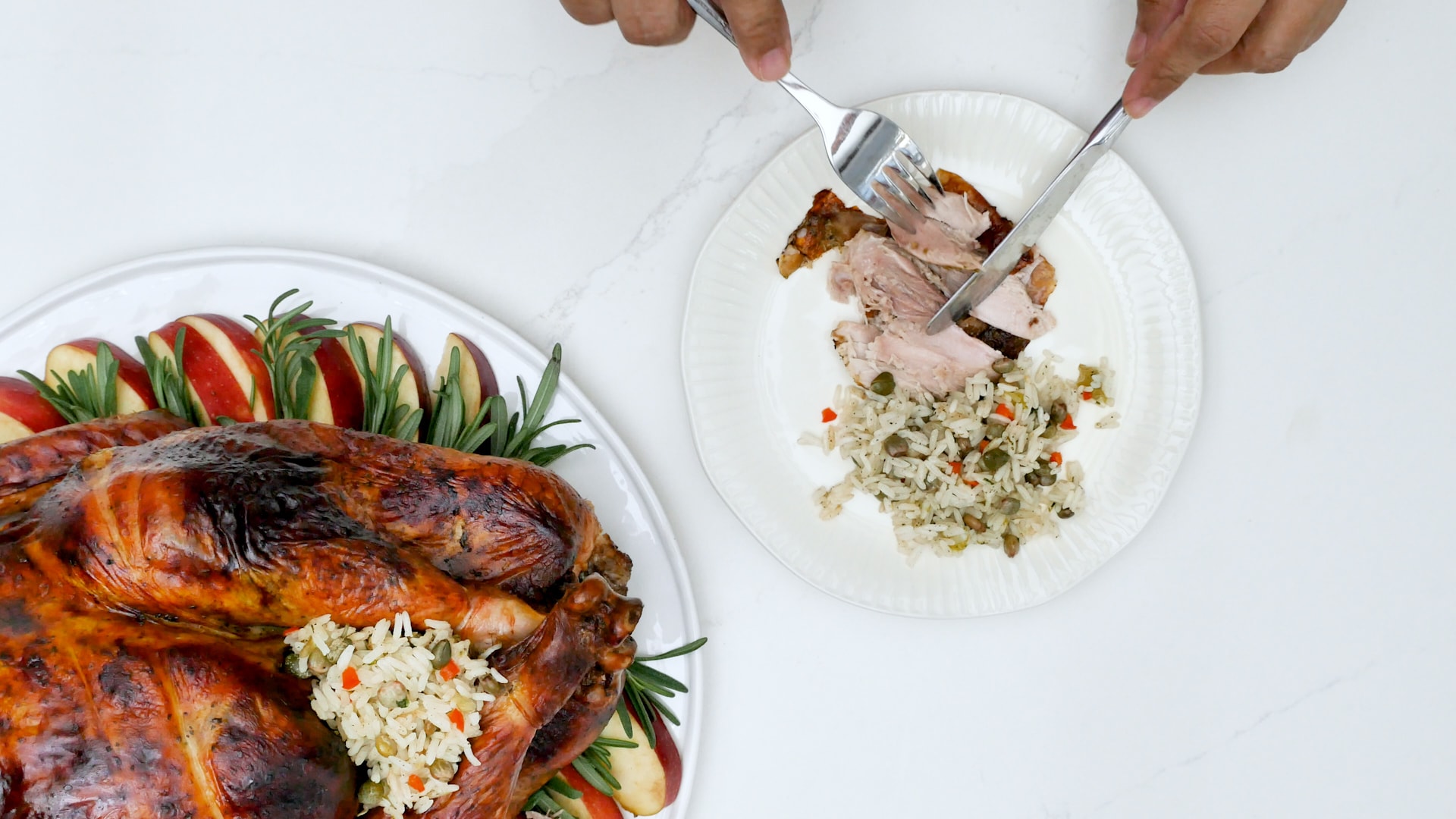 Serving: Once done, remove from the oven and cover the pan with a clean tea towel. Let it rest for 20 minutes before serving.When it is time to serve, mix the stuffing with the rest of the reserved moro, heat the mixture until steam comes out, and stuff again, leaving part of the rice visible.
Serving: Once done, remove from the oven and cover the pan with a clean tea towel. Let it rest for 20 minutes before serving.When it is time to serve, mix the stuffing with the rest of the reserved moro, heat the mixture until steam comes out, and stuff again, leaving part of the rice visible.
Video
Tips and Notes
Nutrition
Nutritional information is calculated automatically based on ingredients listed. Please consult your doctor if you need precise nutritional information.
References
- Juan Antonion Alix, Villancico (Carol), Santiago, 1908. Translation (mine): "There in the kitchen, sounds of pans, they're taking turkey and pasteles out of the oven".
- El Pavo y El Burro - Los Hijos del Rey
- USDA - How to Safely Thaw a Turkey


